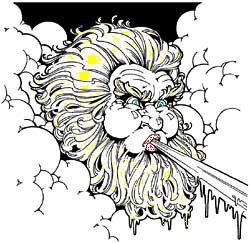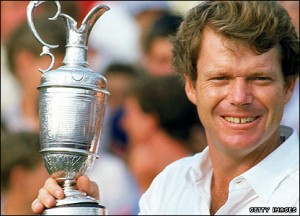 Golf is a game played in beautiful surroundings. Golfers play out in the open air, on golf courses that are usually carefully cultivated and highly manicured playgrounds, where their bright white golf balls gleam against the green grasses that fill the fairways. Even the hazards the golfers try to avoid can be visually appealing. Bunkers are filled with fine-grained white or nearly white sand, shaped by the golf course architects to be visually distinctive and placed so as to present shot-shaping challenges to even the most skilled players. Water hazards can be small ponds, large lakes, babbling brooks, or virtually any manner of water form, again designed to balance visual appeal with golfing challenge. But the most treacherous of all hazards — the hazard dreaded by even the most skilled professionals — is invisible. It’s the wind.
Golf is a game played in beautiful surroundings. Golfers play out in the open air, on golf courses that are usually carefully cultivated and highly manicured playgrounds, where their bright white golf balls gleam against the green grasses that fill the fairways. Even the hazards the golfers try to avoid can be visually appealing. Bunkers are filled with fine-grained white or nearly white sand, shaped by the golf course architects to be visually distinctive and placed so as to present shot-shaping challenges to even the most skilled players. Water hazards can be small ponds, large lakes, babbling brooks, or virtually any manner of water form, again designed to balance visual appeal with golfing challenge. But the most treacherous of all hazards — the hazard dreaded by even the most skilled professionals — is invisible. It’s the wind.
A golf ball is 1.62 inches in diameter and weighs only 1.62 ounces, so it’s easy to see how a strong wind can blow a golf ball well off its intended line of flight. Even the best players in the world have a tough time with the wind. Wind speed is hard to read and wind gusting makes it tough to predict the effect on the golf ball, and to commit to the shot. The average score in the first 4 rounds of the 2009 Bob Hope Classic was 67.0 (there was very little wind). The wind picked up in the final round and the average score was 70.4, which is 3.4 shots higher. The wind really makes it difficult for all of us, even the pros.
The better a player you are, the more the wind bothers you. Think about it. Highly skilled golfers practice, practice, and practice some more. They work to establish consistency with their golf swing, so that they can control the trajectory and the distance that they hit shots with every club in their bag. Then the wind starts blowing and all of that consistency can go out the window in a heartbeat. Because the wind is fickle, even capricious; it blows in one direction, then shifts and swirls to blow in a different direction. Then, when you least expect it, just when you have taken a stronger club to compensate for the 20-mile per hour breeze blowing directly in your face, the wind will “lay down” and you launch the ball over the green into an impossible lie. You can almost imagine the wind laughing at you as you walk dejectedly to your ball and try to recover by pulling off some kind of miracle to save your par.
 The wind gets into your head, sapping your confidence. You’re never sure exactly how the wind will affect your shot, so you have an extra degree of difficulty trying to picture the shot in your mind before you hit it. This weekend I watched professionals at the PGA Champions Tour event in Newport Beach, California, the Toshiba Classic, struggling with winds gusting to as much as 30 miles an hour. On almost every shot, the professionals conferred with their caddies, studying yardage books, looking at the trees and tossing loose blades of grass in the air to try to decipher the direction and speed of the wind, then factoring all of that information into some kind of mental equation to determine how much the wind would affect their standard or “stock” shot before selecting a club. But it was clear that doubt had also entered into the equation, and doubt can infect a golf swing and cause all sorts of bad things to happen. The wind will then gleefully multiply the error and send the ball to some wildly unexpected landing place.
The wind gets into your head, sapping your confidence. You’re never sure exactly how the wind will affect your shot, so you have an extra degree of difficulty trying to picture the shot in your mind before you hit it. This weekend I watched professionals at the PGA Champions Tour event in Newport Beach, California, the Toshiba Classic, struggling with winds gusting to as much as 30 miles an hour. On almost every shot, the professionals conferred with their caddies, studying yardage books, looking at the trees and tossing loose blades of grass in the air to try to decipher the direction and speed of the wind, then factoring all of that information into some kind of mental equation to determine how much the wind would affect their standard or “stock” shot before selecting a club. But it was clear that doubt had also entered into the equation, and doubt can infect a golf swing and cause all sorts of bad things to happen. The wind will then gleefully multiply the error and send the ball to some wildly unexpected landing place.
The wind can take a game that is fun to play, even when you aren’t playing your best, and turn it into a tedious, tiring, almost painful slog. Wind can make an eighteen hole round seem like it lasted 18 hours. Wind can wear you out and break you down. Wind can make you feel helpless. And wind can make you feel old. On Sunday, I watched Peter Jacobson, Craig Stadler and Hal Sutton, three stalwarts on the Champions Tour — between them they have won 35 regular PGA Tour events, two of them major championships, and 10 Champions Tour events, including 6 “senior” major championships, and collectively have earned more than $45 million in prize money — almost staggering off of their final green, looking not so much like professional athletes, but more like three tired old men, happy to be finished with their golf so they could head for the bar and a whiskey or two to restore their damaged spirits. The wind can do that to you.
This isn’t only due to the wind’s affect on the flight of the ball. No, the wind also affects the way your brain works; kind of like being upside-down or submerged in water, you can become easily confused. Everything about playing on a windy day will be more difficult; that part is beyond your control. When you hear about people being good wind players, it’s because they’ve developed the ability to scale back not only their golf swings, but also their egos and their expectations. A good analogy is going from driving a Corvette to driving a Volkswagen Beetle. Trying to get the same performance from the Beetle simply is not possible. Yet when many golfers play on windy days, they feel as if they’ll be able to play the same shots as when it’s calm. At the end of the round, the numbers aren’t pretty.
 Good wind players realize that nobody scores better, or has an easy time of it playing in breezy conditions, and that realization seems to calm their brain’s initial apprehensions. and inspires them to high levels of performance. Tom Watson, one of the greatest golfers of all time — a five-time winner of the British Open and two-time winner of the Senior British Open — often said he loved playing in the wind. Watson figured that most of the other competitors would try to fight the wind and complain about it, rather than accept that they had to adapt their swing and their expectations to the conditions. As a result, Watson felt that he really only had to beat a few other solid competitors, since most of the field would play themselves out of contention.
Good wind players realize that nobody scores better, or has an easy time of it playing in breezy conditions, and that realization seems to calm their brain’s initial apprehensions. and inspires them to high levels of performance. Tom Watson, one of the greatest golfers of all time — a five-time winner of the British Open and two-time winner of the Senior British Open — often said he loved playing in the wind. Watson figured that most of the other competitors would try to fight the wind and complain about it, rather than accept that they had to adapt their swing and their expectations to the conditions. As a result, Watson felt that he really only had to beat a few other solid competitors, since most of the field would play themselves out of contention.
All of this may be interesting, but what do you make of it if you are part of the 91% of the US population that doesn’t play golf? Here’s my take:
- S**t happens. You rarely are in complete control of your circumstances, so it pays to be flexible and adaptable.
- Stay calm. When things start going wrong and most people rush around in a panic, the cool, calm and collected few usually turn out to be the winners.
- Check your ego at the door. It doesn’t matter what you did on your best day, what counts is how you perform today, getting the best out of the situation you find yourself in.
Dave — There were two things about Florida weather that surprised me; it’s not humid from November to May, AND the wind blows All the time. If we have 6-8 mph winds its like no wind at all. Usually it’s 15-18 mph at sometime during every round. We had our Member-Guest a few weeks ago and it was a steady 20-25 with gusts of 30-40. Try playing 27 holes in that.
I’m not sure I’m a better wind player now, but I’m so used to it that I don’t let it get in my head like It once did. At least not all the time, that is. — Rudi
You make a great point about how you “get used to it,” at least some times. That’s true with a lot of other things that put you off your game in the Game of Life. You can learn to deal with those things that disrupt your success pattern. But when the wind is blowing so hard that the flagsticks bend over, you can hear your pants flapping hard in the breeze, and even the birds can’t fly like they normally do……….